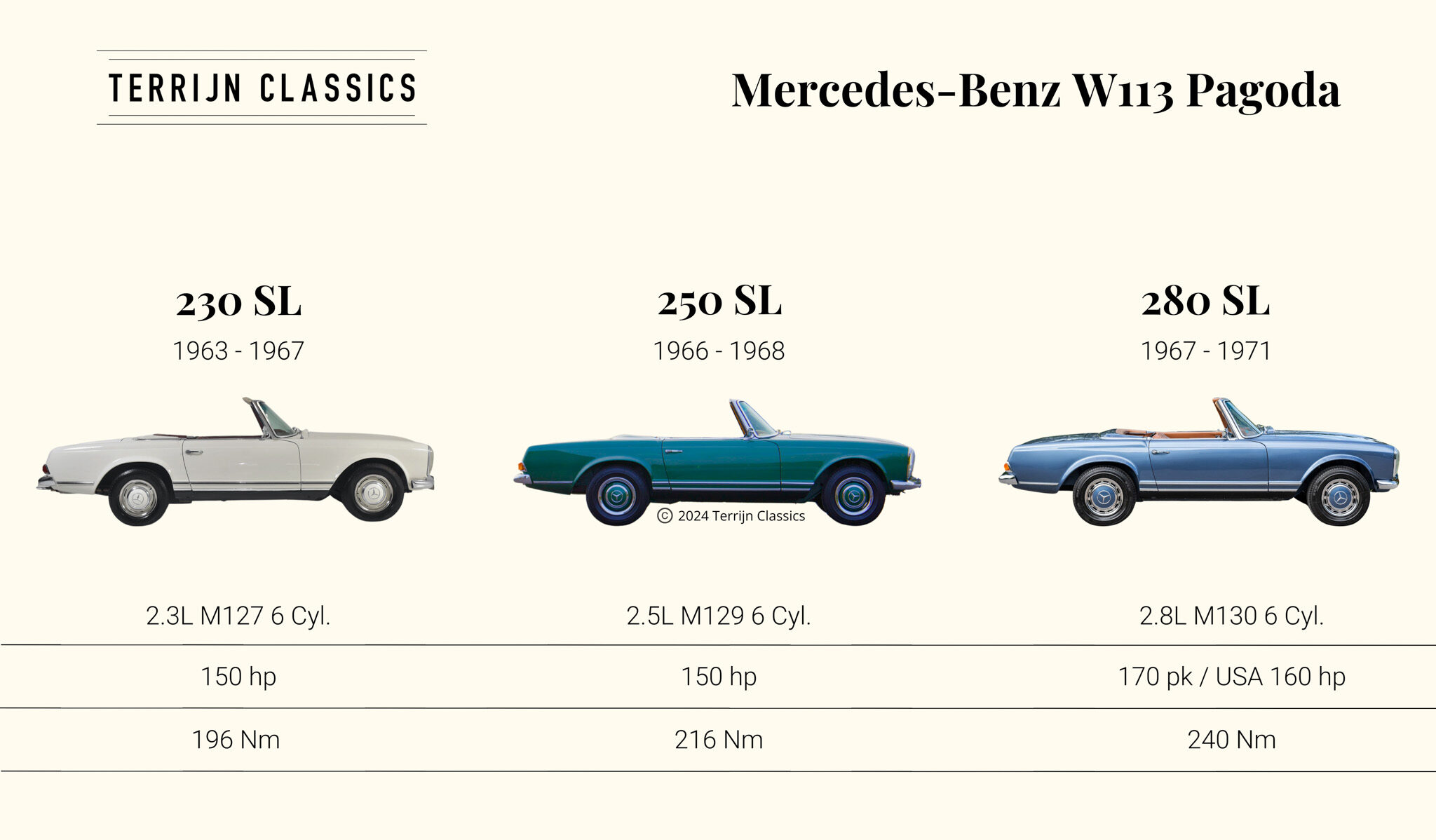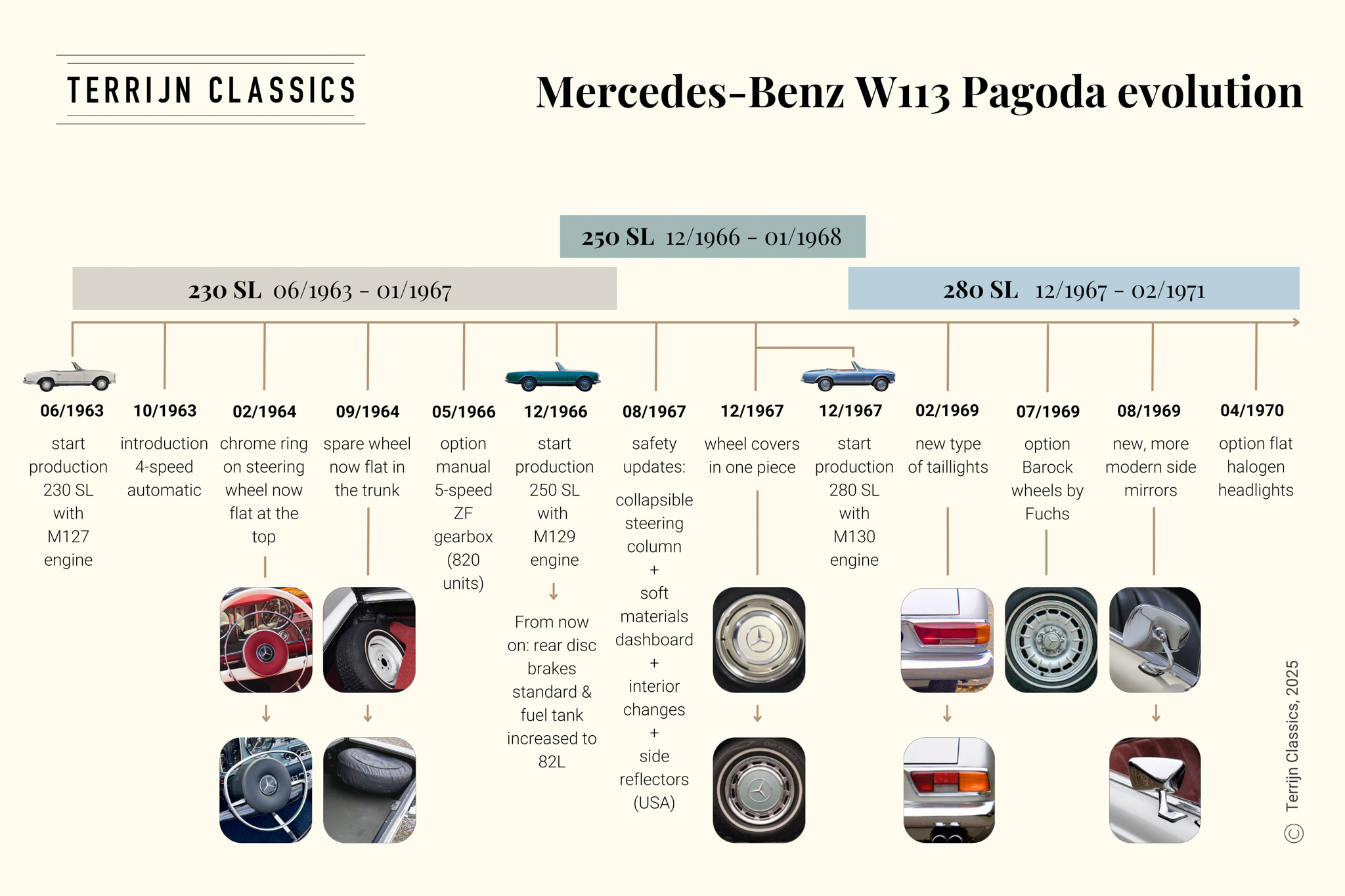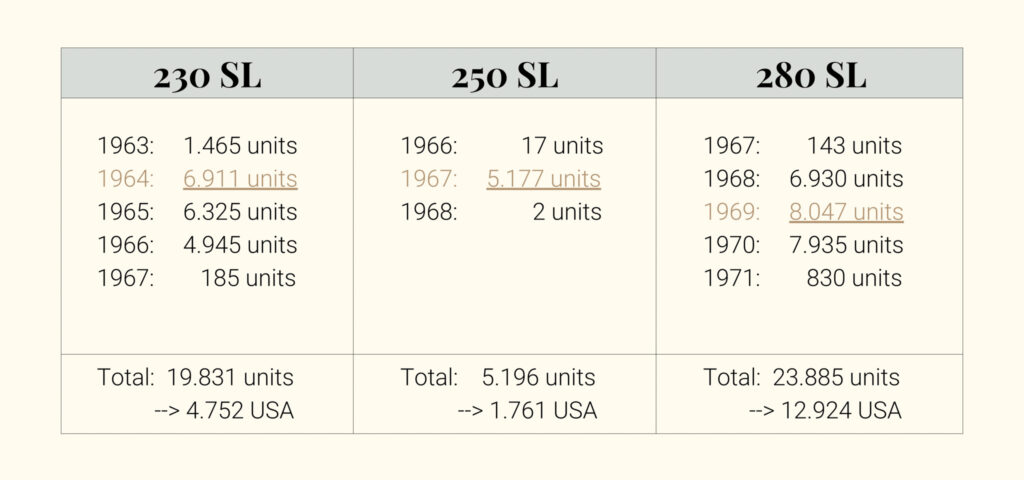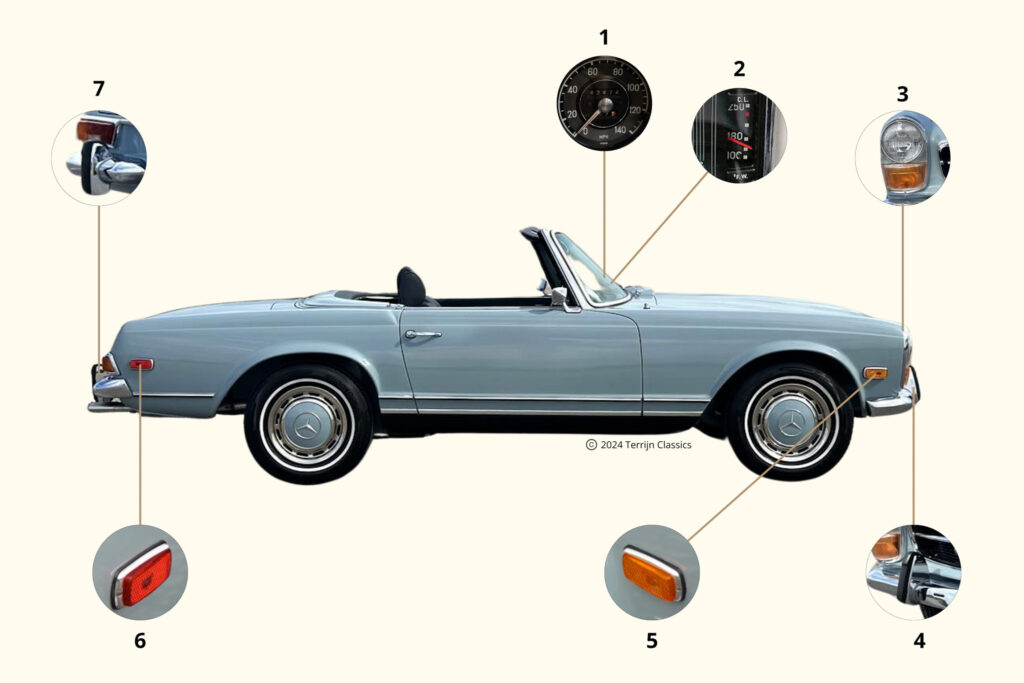Mercedes-Benz W113 Pagoda model overview
The Mercedes-Benz W113, better known as the Mercedes Pagoda, is an icon of the 1960s. Once a symbol of success and luxury, today it is one of the most beloved and recognizable classic Mercedes convertibles. With its timeless design and perfect balance between elegance and comfort, the W113 is highly versatile and cherished by enthusiasts and collectors alike.
In this overview, we take a closer look at the W113 models and the differences between the generations. We discuss the exclusive California Coupé and compare the European Pagoda with the USA version. Additionally, we answer frequently asked questions with insights from our hands-on experience.
Curious about the Pagoda’s place within the rich history of the Mercedes-Benz SL? Discover it in our comprehensive guide!
On this page, you will learn more about:
- The generations and evolution of the W113 over the years
- The pros and cons of each generation
- The USA version and production figures of the W113 Pagoda
- Frequently asked questions about the Pagoda model
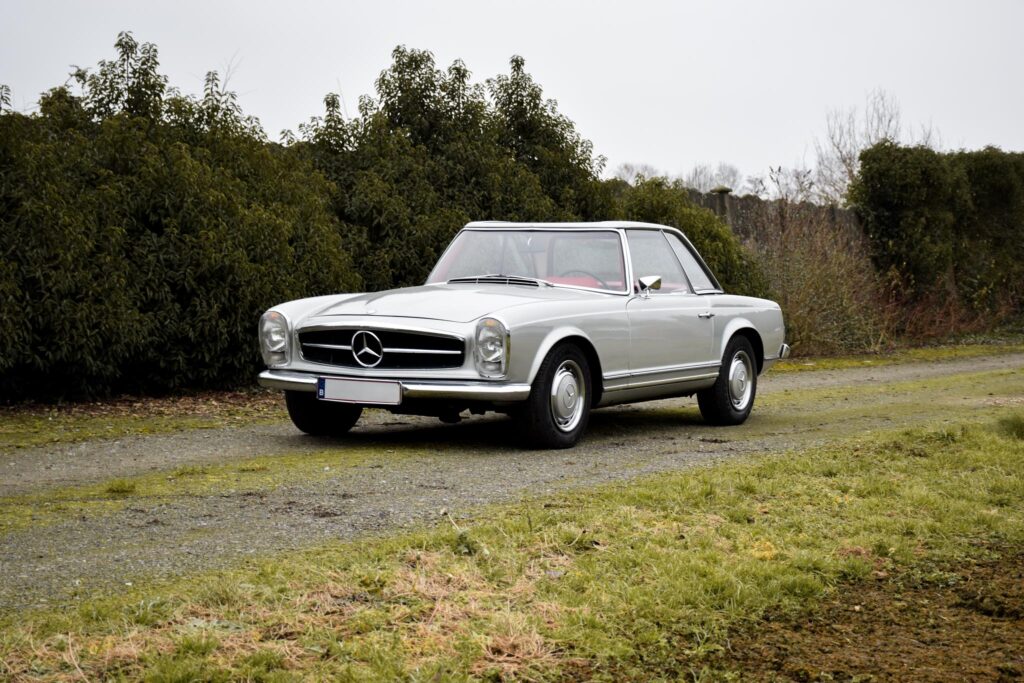
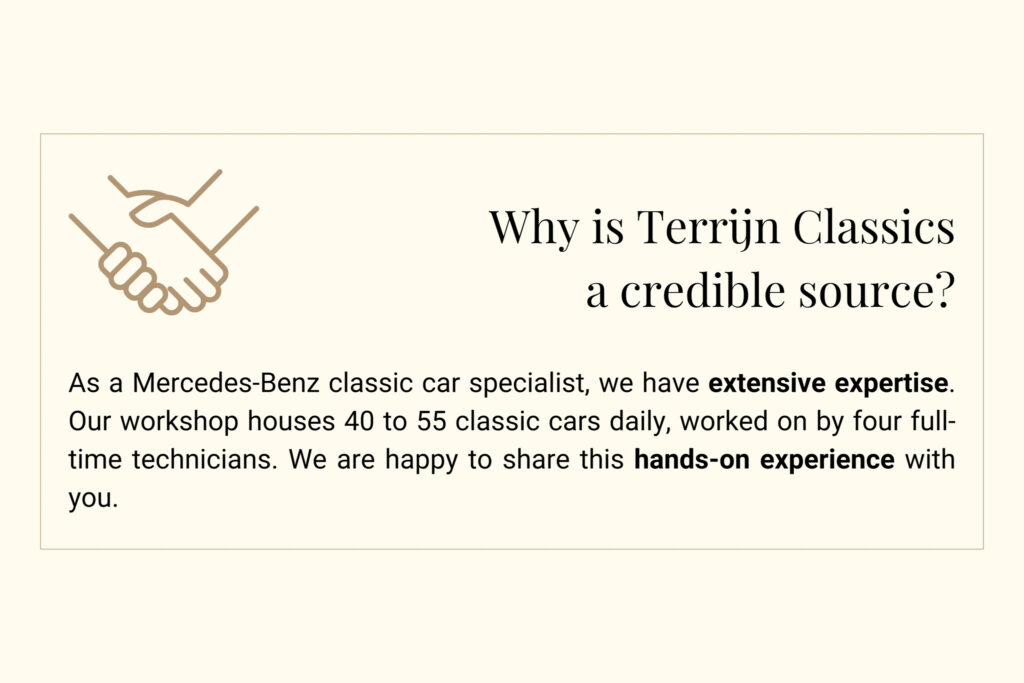
Generations and evolution over the years
As with most classic Mercedes SL models, the W113 underwent several updates over the years. These improvements were implemented across three generations, as shown in the image. The models briefly overlapped in production but were always considered successors to one another. The series began with the Mercedes 230 SL, followed by the Mercedes 250 SL – which was produced in limited numbers and for a short period – and ultimately reached its final evolution with the Mercedes 280 SL.
The modifications ranged from subtle visual changes to technical improvements that were hardly noticeable to the driver. The most significant change, both in terms of technology and driving experience, was the engine, which was upgraded with each generation. Additionally, both the interior and exterior were refined, giving the car a sleeker and more modern appearance. However, throughout its entire production run, the Mercedes Pagoda remained fundamentally true to its original design.
From its introduction to the end of production, the Mercedes W113 underwent hundreds of small improvements and adjustments. Below, we present some of the most notable evolutions in a timeline.
06/1963 Introduction of the 230 SL with the M127 engine.
10/1963 First four-speed automatic transmission becomes available.
02/1964 Chrome trim on the upper part of the steering wheel is now flat instead of round for better instrument visibility.
09/1964 Spare wheel is now positioned flat in the trunk instead of upright.
05/1966 Manual ZF five-speed gearbox available (only 820 units produced).
12/1966 Introduction of the 250 SL with the M129 engine. Various improvements are introduced, including standard rear disc brakes and an increased fuel tank capacity from 65 to 82 liters.
01/1967 Production of the 230 SL ends.
08/1967 New safety features introduced, including a collapsible steering column in case of accidents and soft-touch controls. Interior updates and side reflectors added to the fenders on U.S. models.
12/1967 Wheel covers now made out of a single piece.
12/1967 Introduction of the 280 SL with the M130 engine.
01/1968 Production of the 250 SL ends.
02/1969 New taillights for all models.
07/1969 Barock wheels by Fuchs now available as an option.
08/1969 New, more modern side mirrors.
04/1970 Flat halogen headlights available as an option.
02/1971 Production of the 280 SL ends.
06/1963 Introduction of the 230 SL with the M127 engine.
10/1963 First four-speed automatic transmission becomes available.
02/1964 Chrome trim on the upper part of the steering wheel is now flat instead of round for better instrument visibility.
09/1964 Spare wheel is now positioned flat in the trunk instead of upright.
05/1966 Manual ZF five-speed gearbox available (only 820 units produced).
12/1966 Introduction of the 250 SL with the M129 engine. Various improvements are introduced, including standard rear disc brakes and an increased fuel tank capacity from 65 to 82 liters.
01/1967 Production of the 230 SL ends.
08/1967 New safety features introduced, including a collapsible steering column in case of accidents and soft-touch controls. Interior updates and side reflectors added to the fenders on U.S. models.
12/1967 Wheel covers now made out of a single piece.
12/1967 Introduction of the 280 SL with the M130 engine.
01/1968 Production of the 250 SL ends.
02/1969 New taillights for all models.
07/1969 Barock wheels by Fuchs now available as an option.
08/1969 New, more modern side mirrors.
04/1970 Flat halogen headlights available as an option.
02/1971 Production of the 280 SL ends.
The pros and cons of each model
Each model of the Mercedes W113 has its own pros and cons. Some offer more features, while others are more affordable to purchase. Every classic Mercedes Pagoda can be a great and enjoyable car. Ultimately, the overall condition of the vehicle is the most important factor for driving pleasure and reliability. Of course, every buyer or owner has their own preferences and may value certain features more than others. Below, you’ll find an overview of the strengths and weaknesses of each model.
Mercedes-Benz 230 SL
Advantages:
- Lowest purchase price of the three, while being technically similar to its successors.
- The most underrated model, offering the greatest potential for long-term value appreciation.
Disadvantages:
- Usually fewer comfort options, such as no power steering.
- Limited safety features, including no safety steering column and no rear disc brakes.
Mercedes-Benz 250 SL
Advantages:
- The lowest production numbers of the three, making this model rare.
- Often equipped with the same options and benefits as the 280 SL but at a lower price.
Disadvantages:
- The 250 SL with the M129 engine is considered by some to be less ideal in terms of performance.
- Limited difference in engine power compared to the 230 SL.
Mercedes-Benz 280 SL
Advantages:
- Equipped with the most options and comfort features, often including an automatic transmission.
- Engine with significantly more power than the two previous models.
Disadvantages:
- Higher purchase price compared to earlier models.
- The most-produced variant, with many U.S. versions that have reduced engine power due to environmental regulations.
Mercedes Pagoda USA version & production figures
The USA was already a key market for European car manufacturers at the time. Mercedes-Benz made significant efforts to ensure the success of its popular SL models in the United States. These efforts paid off: approximately 40% of the total production of the Mercedes W113 (1963-1971) was exported to the USA.
Over the years, the share of U.S. exports increased. For the Mercedes 230 SL, only 24% of production was shipped to the USA, whereas for the 280 SL, this number had risen to 54%. This trend continued with the R107 SL, the Pagoda’s successor, of which an impressive 63% of total production was destined for the American market. More details on this can be found in our R107 model overview.
In the image below, you can see the main differences between the European and American versions of the classic Mercedes Pagoda. Not all modifications were present from the beginning, as U.S. regulations became stricter over the years. As a result, later U.S. versions generally include more of these changes than earlier models.
When imported to Europe, visible features are often modified for aesthetic reasons. For example, orange reflectors are frequently removed when the body is repainted. Aftermarket conversion kits are available for bumpers and headlights, though their quality varies significantly. Additionally, speedometers can be converted to km/h.
Technically, the differences are minimal, except for the reduced engine power in the U.S. version of the Mercedes 280 SL, which produces 160 hp instead of 170 hp due to environmental regulations.
Frequently asked questions about the Mercedes-Benz W113 Pagoda
When considering a Mercedes-Benz W113 Pagoda, many questions often arise. In this section, we answer the most common questions about the W113 and provide tips to help you avoid a bad purchase. Do you still have other questions? Feel free to contact us, we’re happy to assist you!
The driving experience of a Mercedes Pagoda can vary significantly depending on the available options. A well-equipped Pagoda drives noticeably differently from a model without additional features. Over the years, the option list evolved, with some features becoming standard in later production years. Additionally, buyers in the later production period were more likely to select extra options at the time of purchase.
When buying a classic Mercedes Pagoda, certain options are more important than others, depending on personal preference and driving comfort. Below is an overview of the most influential or desirable options:
- Power steering (can also be retrofitted)
- Automatic transmission or manual ZF 5-speed gearbox
- Leather upholstery instead of MB-Tex (both high quality)
- Barock Fuchs wheels (easily retrofitted)
- Right-side mirror (can be easily added later)
- Hardtop in the same or a matching color
- Rear seat/third seat (can be retrofitted)
- Headrests on the front seats
- Electric antenna (can be installed later)
- Front seat belts (easy to retrofit in certain models)
- White steering wheel (can be retrofitted)
These options not only enhance driving comfort and aesthetics but can also increase the car’s value and desirability.
The value of a Mercedes Pagoda is a crucial factor when making a purchase. The price difference between the cheapest and most expensive examples is significant, and for good reason. The condition of the car plays the biggest role, but the model variant, color combination, and available options can also greatly impact its value.
Below, we provide an indication of the different price categories for the 230 SL, 250 SL, and 280 SL. Keep in mind the following:
- Within each price category, there is significant variation: the better the condition of a car, the closer it falls to the higher category.
- Not every Pagoda on the market is actually worth its asking price. Many cars are advertised as “perfectly maintained,” while in reality, they require substantial repairs.
- A car with desirable options is generally worth more than a comparable example without those features.
When evaluating a Mercedes W113, a thorough inspection is essential to avoid unpleasant surprises.
The condition of a Pagoda can generally be classified into five categories:
Category 1 – Project cars
- Vehicles with significant visual and technical defects.
- Usually drivable but unreliable and in poor condition.
- Requires a complete restoration to be roadworthy and presentable.
Category 2 – Drivable cars with work needed
- Decent cars that require investment to become technically reliable.
- Often needs mechanical improvements, bodywork repairs, and replacement of aged components.
Category 3 – Good condition, light restoration possible
- Well-maintained cars in good technical and visual condition.
- Reliable for driving, but still has room for minor restoration or improvements over time.
Category 4 – Very nice, thoroughly restored cars
- High-quality examples with few to no defects.
- Both technically and visually in great shape, professionally restored.
- No major expenses expected, except for minor detailing or fine-tuning.
Category 5 – Top restorations
- Exceptionally restored cars by companies with great renown.
- Absolutely flawless, with no mechanical or visual defects.
- Better than new and with desirable color combinations or configurations.
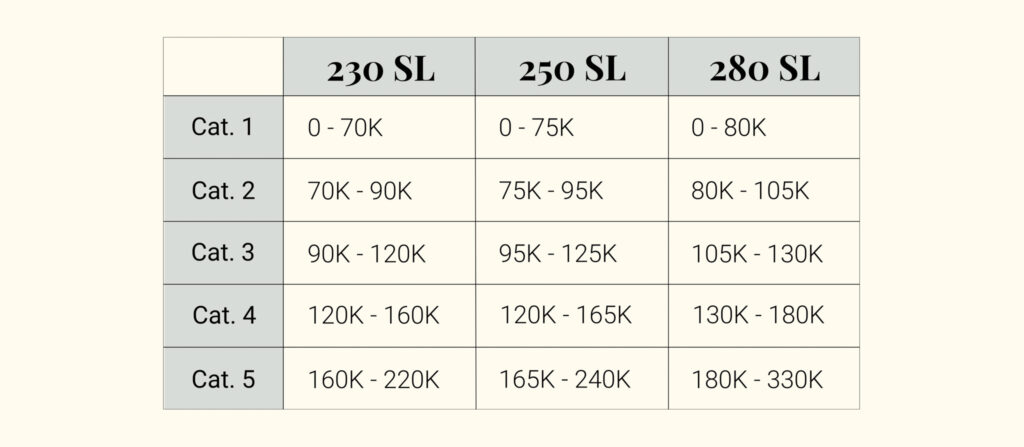
Every Mercedes Pagoda can be a fun and reliable classic. The choice between different versions depends on what matters most to you and which car you come across at the right time. Be sure to compare the pros and cons of each model, as discussed earlier on this page.
It’s important to understand that a Mercedes 280 SL in good condition will drive far better than a poorly maintained 280 SL. In fact, this difference is even more significant than the differences between the three SL models themselves. For example, a well-preserved 230 SL or 250 SL will provide a much better driving experience than a 280 SL in mediocre or poor condition.
Both options are possible, but the most important thing is to know what you are buying.
- Fully restored cars are hassle-free to use and come with minimal unexpected costs, but their purchase price is significantly higher.
- Partially restored cars are common. For example, a car with a rebuilt engine but old axles or a worn interior. This doesn’t have to be an issue, as long as you account for additional restoration costs in the years after purchase. This allows you to gradually improve the car. However, it is essential that the previous restoration work is of high quality. Otherwise, you may end up paying for a restoration that will need to be redone later. Unfortunately, poor-quality restorations are more common than one might hope, often due to a lack of knowledge and experience.
- The biggest risk with a Mercedes Pagoda is buying one with a compromised foundation, meaning severe rust in the bodywork. This can make a restoration extremely expensive and leave you with a tough decision:
- Go all the way with a full restoration — this is time-consuming and costly.
- Sell the car and look for a better example.
- Patch it up and keep driving until it’s beyond saving.
The issue with a rusty body is that partial restorations are not an option. To properly tackle rust, the entire car must be disassembled and treated. If this is not done, you could be facing the same rust issues 10 years later. Additionally, many disassembled parts are often in poor condition, meaning you may need to replace and restore nearly everything.
We can help you with the full or partial restoration of your Pagoda. Check out our services for more information.
A pure classic sports car in the style of Ferrari or Porsche was never part of Mercedes-Benz’s commercial lineup back then. This was never the brand’s intention when developing its models. Comfort has always been a key aspect of a classic Mercedes SL, whereas in a true sports car, it is often of secondary importance.
That said, the Mercedes W113 Pagoda delivers a highly sporty driving experience. The car is fast, agile, and performs exceptionally well on winding roads. Upon its debut, the Mercedes 230 SL nearly matched the lap time of a Ferrari 250 GT with a V12 engine on a twisty circuit.
A well-maintained and properly tuned Mercedes W113 offers more than enough driving enjoyment for 95% of drivers. The big advantage is that you don’t have to sacrifice comfort when driving casually — something that is less common in pure sports cars.
If you are considering buying a Mercedes-Benz Pagoda, it is important to be well-informed. Many enthusiasts make a bad purchase by focusing too much on the car’s appearance, without paying enough attention to the bodywork and mechanical condition.
The Mercedes Pagoda belongs to a higher price range, meaning that technical issues are often relatively simple and affordable to fix compared to the purchase price. The biggest risk when buying one is a compromised body structure. If the car has serious rust problems, a full restoration may be the only viable solution. This is an expensive and time-consuming process, making a thorough inspection beforehand absolutely essential.
We are happy to assist you in finding the right car and avoiding hidden flaws. Interested in our purchasing advice? Please take a look here.
A hardtop can be a valuable addition to your Mercedes-Benz W113 driving experience, depending on how and when you use the car. For those who enjoy driving early in spring or late in autumn, the hardtop provides extra comfort, particularly in terms of warmth and sound insulation. Since convertible driving is often less appealing during these seasons, a hardtop can be a practical solution.
Additionally, the hardtop is often used by owners who drive long distances to destinations such as a second home in France or Spain. On the highway, the hardtop significantly reduces wind noise at higher speeds. Once you arrive, it can be easily removed and stored, allowing you to fully enjoy the convertible experience for the rest of your stay.
While a hardtop is not essential, it can be a valuable option depending on your usage. Some owners use it frequently, while for others, it simply takes up space in the garage.
The Mercedes-Benz W113 is known as a highly reliable classic, provided that its mechanical components are well maintained. A Pagoda will typically only let you down if its technical condition is not optimal and has not been preventively inspected. This is often due to neglected maintenance, wear, or age-related issues.
A common example is a faulty fuel pump, which can lead to breakdowns. For an overview of the most common issues, you can read more here: Mercedes Pagoda Problems.
At Terrijn Classics, we have developed a Health Check: a preventive and systematic inspection of all the car’s systems. More information about this service can be found on the following page: Health Check.
The costs of owning a Mercedes W113 Pagoda can be divided into fixed and variable expenses. Thanks to the steady increase in value of these classic cars, many owners eventually break even or even make a profit, especially if they keep the car for an extended period.
FIXED COSTS:
-
Insurance:
- Liability insurance: €150,00 – €250,00 per year
- Comprehensive insurance (Omnium): From €550,00 up to 1.2% of the insured value per year, depending on the insurer and conditions. The premium is typically adjustable for insured amounts above €50.000,00.
-
Road tax:
- Annual tax: ± €105,00 (fixed amount, regardless of engine displacement and emissions).
- One-time registration fee: €55,00 (fixed amount, regardless of engine displacement and emissions).
VARIABLE COSTS:
-
Maintenance and repairs:
-
- Fully restored Pagoda in excellent condition: Limited costs for regular maintenance and wear parts, averaging €400,00 – €1.000,00 per year.
- Car in average condition with aging components: Requires annual repairs and improvements, with costs ranging from €500,00 to €5.000,00 per year.
- Unexpected expenses: Major repairs such as an engine rebuild or a faulty transmission can be costly. However, these expenses are typically predictable, and we provide advance warnings to help you anticipate them. Such investments increase the car’s value, as they contribute to the gradual restoration and improvement of the vehicle.
-
-
Fuel consumption:
-
- A well-tuned classic Mercedes Pagoda consumes an average of 10 to 15 liters per 100 km.
- Automatic transmission models consume slightly more than manual versions.
- Long drives & road trips: ± 10 liters per 100 km.
- Short trips: ± 15 liters per 100 km.
-
By considering these costs in advance, you can realistically estimate the financial commitment of owning and maintaining a Mercedes W113 Pagoda.
This is an alternative version of the classic Mercedes Pagoda, delivered without a soft top. This model was available in the 250 SL generation and continued with the 280 SL. As a result, drivers could either enjoy fully open driving, with no option to close the roof in bad weather, or drive with the hardtop mounted.
The big advantage of this design was that the missing soft top created space for a rear bench with two seats. This version was primarily delivered to sunny regions with stable climates. Apart from this difference, its mechanical components are identical to those of the standard versions. For those who prefer driving with the hardtop or are always guaranteed good weather, this can be an attractive classic Mercedes-Benz convertible.
Today, some California Coupés are converted into a standard Pagoda with a soft top, as these tend to be more valuable. However, this is a complex modification, as significant structural differences exist between a California Coupé and a regular Mercedes Pagoda. As a result, both converting a car or buying a converted model is generally not recommended.
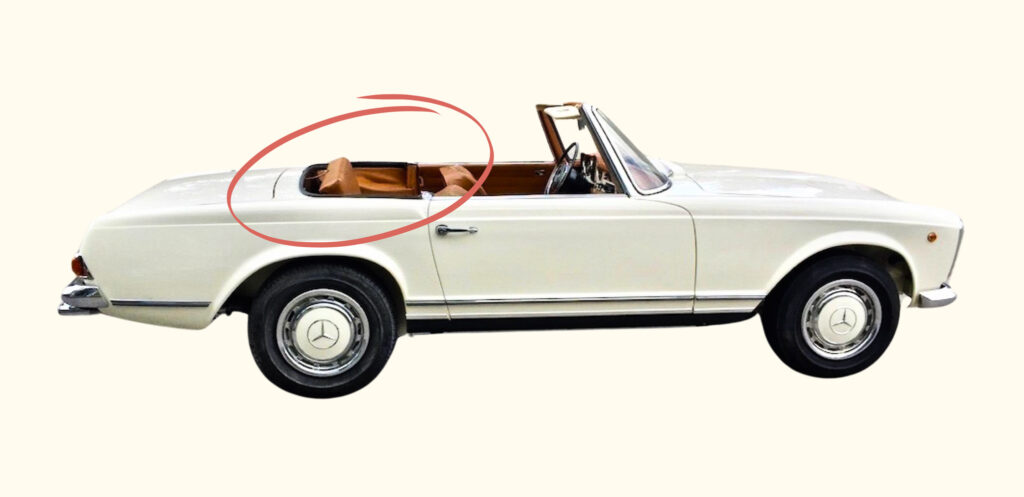
Depending on what you’re looking for, Mercedes classic cars come in various body styles, price ranges, and configurations. The most prominent model series include the S-Class, E-Class, and, of course, the SL-Class, which also includes the Pagoda. Within the range, you can find coupés, sedans, and classic Mercedes convertibles.
For more information, check out the following articles:
- Overview of all classic Mercedes models: Mercedes-Benz classic model overview
- SL models and generations: Mercedes-Benz SL classic overview
- Convertible versions: Mercedes-Benz convertible classic overview

